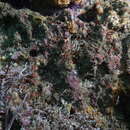en
names in breadcrumbs


Pistaare restricted to the marine environment and are deposit, interface and suspension feeders.Pista are known to have lateral lippets on segments 2 and 4.To identify the species of annelid, one must remove at least one parapodia and which parapodia depends on the family. ForPista the anterior, median and posterior thorasic parapodia must be removed. A description by Hutchings and Glasby (1990) note that they have'Tentacular lobe with numerous buccal tentacles. Lateral lobes on segments 2-4 and sometimes on peristomium. Branchiae, 1-3 pairs on segments 2-4. Notopodia from segment 4, continue for 17 segments; notosetae smooth-tipped, winged capillaries. Neuropodia begin on segment 5 (setiger 2); uncini of anterior thoracic segments typically with posteriorly elongated bases, following uncini lacking elongated bases. Uncini arranged in single rows initially, in double rows from uncinigerous segment 7 to end of thorax, abdominal uncini arranged in single rows.''TypicalPistahave two pairs of branched branchiae that are unequal in size, hooks (called uncini) that are crested, one pair of nephromixia (antirior) and two seperate reproductive nephromixia. The anterior uncini are long-handled and notosetae with smooth tips from segment 4. Some, includingP. pacificaandP. elogata, are known to have three branchiae, unicini in a crochet-like form and more reproductive nephromixia. This leads Smith (1992) to believe that they are notPistiabut points out that there is no fitting genus.
Pista is a genus of polychaete worms comprising around 100 species.[1]
Pista is a genus of polychaete worms comprising around 100 species.